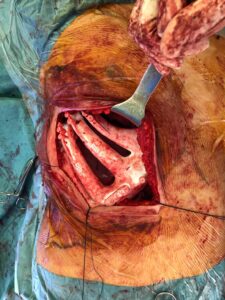Australia based Anatomics was an early pioneer in using 3D printing for surgeries. Under Neurosurgeon Paul D’Urso the firm has done a lot of work in personalized implants, surgical planning and 3D printed medical devices. In thoracic surgery, CMF implants and orthopedics the firm has rolled out software solutions as well as implants and materials for surgeons to use. Patient-specific surgical tools, patient-specific spinal cages, sternums or software to design surgical implants.

Now Anatomics worked with Singapore’s Tan Tok Seng Hospital to do a world-first, a Polymer ribcage reconstruction. Using Anatomics’ StarPore polymer tissue scaffold a 26 year old cancer patient who needed a new ribcage was helped. The surgery was a success and the patient went home after two days. In addition to the 3D printed ribcage reconstruction itself, patient-specific surgical guides, medical models and cutting guides and templates were also created to aid the surgery.
The StarPore has, “strength, flexibility and its capacity to allow cell and tissue ingrowth. StarPore scaffolding will last for a patient’s life span whilst keeping the same shape, with natural tissue holding it in place. The material provides a scaffold for human tissue to grab onto and grow into, due to biological trabecular porosity similar to that found in the body.”
The surgery was conducted by Dr Aneez Ahmed, Head of Service of Thoracic Surgery at Tan Tock Seng Hospital, and his team. Dr Ahmed says that,
“There’s nothing like a like for like comparison with the StarPore solution for this case. Thus the StarPore solution definitely improves the patient’s health outcome as there is no alternative possible…An important advantage of the Anatomics solution was the ease of use. Instead of doing one rib at a time, multiple times, in the conventional way, we cut out and detached the affected chest wall and inserted the implant easily, making the reconstruction very easy. “The Anatomics personalized solution (StarPore implant, BioModel, 3DP cutting guide and 3DP implant positioning template) helped achieve the success. The usual chest wall reconstruction takes an average of about 4-6 hours. We were able to do this case in about two and a half hours”
Patient-specific implants have long been touted as the future of implantology and orthopedics. Theoretically, they should result in quicker procedures, less blood loss and faster recovery times. In some cases, this may be true while in others a standard implant could suffice. In the case of novel procedures however 3D printing coupled with digital surgical planning is becoming a tried and tested route to the unknown and big new results. The integrated approach seen here would derisk the procedure somewhat and make planning an execution much clearer. I would assume that there would be value in something fitting right the first time but absolutely know that there is value in personalized cutting guides and specific labeling to make sure that errors are reduced; especially with lengthy, new or complex procedures.

The post Singapore: World’s First 3D Printed Polymer Ribcage Reconstruction appeared first on 3DPrint.com | The Voice of 3D Printing / Additive Manufacturing.
